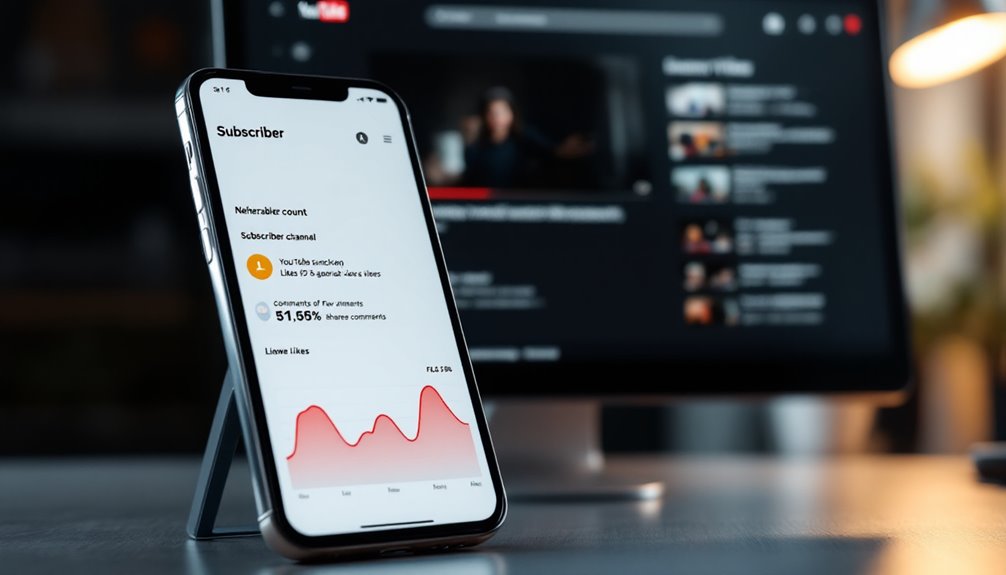
You might wonder how to spot if someone's buying likes on YouTube. Look for sudden spikes in likes without matching view or comment increases—these could signal manipulation. A skewed like-to-view ratio, usually between 3.75% and 4%, is another red flag. Minimal comments alongside high likes also suggest fake interactions. Observing uniform timing of likes and generic usernames can reveal bot activity. But what are the deeper implications of such artificial engagement?
Key Takeaways
- Sudden spikes in like counts post-upload without corresponding views often indicate potential like manipulation.
- Disproportionate like-to-view ratios outside the typical 3.75% to 4% range suggest bought likes.
- High likes with minimal comments or shares signal artificial engagement activities.
- Uniform, rapid timing of likes shortly after posting is a red flag for bot activity.
- Lack of profile pictures and generic usernames often belong to fake accounts.
Sudden Spikes in Like Counts

If you've noticed a sudden surge in like counts soon after a video is posted, it might be worth investigating further. Such spikes can undermine like authenticity and engagement integrity, signaling potential manipulation. When likes accumulate rapidly, especially within hours, it raises suspicion of automated systems or fake accounts. This quick influx often lacks corresponding views or comments, highlighting a possible discrepancy in genuine interaction. Traffic sources can reveal where likes originated, providing insight into whether they are legitimate or artificially inflated. Additionally, unusual timing patterns that don't match the video's upload schedule suggest artificial activity. You should be on the lookout for immediate likes without other engagement signals. Many creators buy likes to boost visibility and credibility, which can be a strategic, albeit controversial, move in the competitive YouTube landscape.
Disproportionate Like-to-View Ratios
After observing sudden spikes in like counts, another critical factor to examine is the like-to-view ratio. This metric reveals potential like manipulation if the number of likes deviates greatly from the expected range of 3.75% to 4% per 100 views. Such discrepancies suggest engagement authenticity might be compromised, raising red flags about the video's genuine popularity. Calculating this ratio involves dividing likes by views and multiplying by 100, providing a clear benchmark for evaluating content performance. Ratios outside the norm may trick YouTube's algorithm, artificially boosting or diminishing visibility. Understanding these metrics is crucial as like button influences algorithm and user engagement significantly.
Lack of Corresponding Engagement

When you notice a high number of likes with minimal comment activity, it's often a sign of fake engagement. Genuine interaction typically includes shares and comments, so an absence of these alongside disproportionate likes to views raises red flags. Analyzing the balance between likes, comments, and shares can provide insights into the authenticity of the audience's engagement. YouTube's algorithms are designed to flag sudden spikes in likes, which often accompany fake engagement tactics.
Disproportionate Likes to Views
A sudden influx of likes without a corresponding rise in views or other engagement metrics can be a red flag indicating potential manipulation of engagement on YouTube.
Like authenticity and engagement integrity are essential. When a video with 1,000 views suddenly has 500 likes, it's statistically unusual, given the average like-to-view ratio of 4%. This imbalance might suggest fake likes, especially if spikes occur soon after posting, hinting at automated systems.
High likes with few shares or low watch time further indicate artificial inflation. Consistent engagement across likes, comments, and shares should align with historical data.
Analyzing these patterns against average benchmarks can help you spot discrepancies, ensuring that your engagement metrics reflect genuine audience interaction.
Minimal Comment Activity
Identifying suspicious engagement on YouTube requires examining more than just disproportionate likes. Conduct a thorough engagement analysis to spot minimal comment activity, which often signals bought likes. Authentic engagement typically features a healthy mix of likes and comments. When you notice a high number of likes without corresponding comments, it's a red flag for fake engagement. Evaluate comment authenticity; genuine comments usually reflect the content's context and show depth. Repetitive or irrelevant comments may indicate automated activity. Scrutinize the views-to-likes ratio, as a high ratio with minimal comments suggests artificial inflation. Analyze user behavior for sudden like spikes without a matching increase in comments, which indicates potential fraudulent activity. Irregularities in subscriber demographics can also be a signal of manipulation, revealing patterns that deviate from typical viewer behavior. Use these insights to detect and mitigate false engagement.
While high like counts can be enticing, an absence of shares often reveals the true nature of engagement. Share importance can't be overstated, as it serves as a critical indicator of engagement authenticity. When you notice a video with numerous likes but few shares, it suggests artificial interactions. Genuine engagement typically manifests as a balanced mix of likes, comments, and shares. Such inconsistencies often signal fake likes, undermining the video's perceived value. YouTube's algorithm recognizes these patterns, potentially penalizing content with low share counts despite high likes. Anomalous like-to-share ratios highlight the need for analyzing audience behavior, where authentic viewers share content they find valuable. Ultimately, ensuring balanced engagement metrics safeguards both visibility and credibility. Utilizing data-driven insights can further reveal discrepancies in engagement patterns, as statistics and data offer a deeper understanding of viewer interactions.
Identifying Bot-Like Patterns
When you're trying to determine if someone is buying likes on YouTube, recognizing bot-like patterns becomes essential for an accurate assessment.
Start by analyzing sudden engagement spikes. If a video sees a swift surge in likes without a corresponding rise in views or comments, it suggests bot activity. The use of YouTube Engagement Automations can often lead to such artificial engagement patterns. Look for large batches of likes appearing soon after a video is posted—another red flag of automation. Additionally, unexplained spikes that don't align with the content or past engagement trends could indicate artificial manipulation.
Examine the timing of interactions; if likes occur uniformly and too quickly, it points to bots.
Scrutinizing User Behavior

To effectively scrutinize user behavior, focus on analyzing engagement patterns, such as disproportionate likes relative to views or comments. Detect unusual activity by observing if accounts rapidly like multiple videos without meaningful interaction, signaling potential automation. Consistent publishing schedules can also reveal patterns, as channels that maintain regularity tend to have more authentic engagement. Identifying fake accounts often involves noting incomplete profiles or follower discrepancies that suggest inauthentic engagement.
Analyzing Engagement Patterns
Identifying signs of purchased likes on YouTube entails a meticulous examination of engagement patterns that can reveal discrepancies in user behavior. Analyzing like-to-view ratios is essential for evaluating engagement authenticity. A typical ratio hovers around 4%, so any significant deviation might indicate artificial engagement. Discrepancies between likes and comments often highlight a lack of viewer trustworthiness, as genuine interactions usually include comments and shares. If comments don't match positive like sentiments or are absent altogether, it's a red flag. Craft compelling thumbnails can lead to higher click-through rates (CTR), which is an important factor in attracting clicks and enhancing engagement authenticity. Unexpected spikes in likes without corresponding views, demographic mismatches in likes and views, inconsistent comment trends that don't reflect audience interaction, and timing irregularities with likes appearing too quickly are all indicators of potentially purchased likes.
Detecting Unusual Activity
Building on the examination of engagement patterns, detecting unusual activity requires a keen eye on user behavior to uncover potential manipulation.
Start by identifying sudden spikes in likes without a corresponding increase in views or comments. These unusual patterns often signal automated liking. Rapid accumulation of likes shortly after posting suggests engagement anomalies, revealing potential purchase of artificial likes. With the expansion of tools like the "Other Videos Your Audience Watched" feature to smaller channels, creators now have enhanced insights into audience viewing habits over the previous seven-day period, which can aid in identifying such discrepancies.
Pay attention to the timing; likes clustering in a short timeframe lack correlation with other metrics like shares. Analyze viewer demographics—likes from regions not aligned with your content's language or audience hint at fake engagement.
Scrutinize the source of engagement to isolate legitimate interactions from click farming or automated systems. This data-driven approach guarantees authentic audience insights.
Identifying Fake Accounts
Ever wondered how to spot fake accounts on YouTube? Start by scrutinizing user behavior for profile verification and user authenticity.
Analyze profiles for:
- Lack of Profile Pictures: Genuine users typically have personalized images.
- Few Followers: High engagement with minimal subscribers raises red flags.
- Generic Usernames: Names lacking personalization often indicate bot accounts.
- No Uploaded Content: Accounts with no or minimal content may be fake.
Spotting these signs helps identify fake accounts.
Inconsistent comment trends like generic praises or comments within seconds of a video release are also suspect. Bots often produce generic comments lacking originality, such as "Fantastic video!" which can be a clear indication of non-authentic engagement.
Watch for unusual user engagement patterns, such as mismatched demographics or sudden spikes in likes.
Analyzing IP Address Activity
When it comes to analyzing IP address activity on YouTube, understanding its role in detecting bought likes is essential. IP tracking serves as a cornerstone in engagement analysis, ensuring viewer authenticity and location accuracy. YouTube's algorithms utilize this data for bot detection by distinguishing human users from automated scripts. Despite the challenges posed by dynamic IPs and VPNs, patterns in user behavior offer insights into potential manipulation. Yet, analytics limitations exist due to imprecise location data and privacy measures like anonymization. Such restrictions necessitate a focus on engagement metrics, including watch time and like patterns, to assess authenticity. Additionally, IP logging provides crucial information about user device locations and demographics, which aids in optimizing marketing strategies for content creators. Ultimately, IP address analysis complements other strategies, offering a nuanced lens through which to evaluate genuine viewer interactions.
Profile Characteristics of Fake Accounts

Shifting focus from IP address activity, understanding the profile characteristics of fake accounts provides another layer of insight into detecting purchased likes on YouTube.
Recognize fake profile traits by examining account creation and activity. These profiles often emerge suddenly, with suspicious usernames that mix random letters and numbers. They lack personal information and exhibit erratic engagement patterns. Fake accounts are often created for impersonation, extortion, harassment, spreading false information, and damaging reputations, which can severely impact the credibility of a YouTube channel.
Investigate profile pictures and details for low-quality images or avatars, signaling inauthenticity. Observe connections and interactions, as fake accounts rarely engage with content or other users meaningfully.
- Recently created profiles: Often emerge just before they're needed.
- Inconsistent activity: Long inactivity followed by sudden bursts.
- Anonymity and pseudonyms: Profiles hide personal info.
- Suspicious usernames: Generic names with mixed characters.
Timing and Patterns of Likes
When you notice abrupt like surges shortly after a video is posted, it's likely an indicator of automated liking, especially if there's no corresponding increase in views or comments.
Look for inconsistent engagement patterns, such as high likes but low comments, as these suggest artificial boosting.
Genuine interactions typically show a gradual increase over time, aligning with consistent user behavior rather than erratic spikes.
Abrupt Like Surges
A sudden surge in likes on a YouTube video, especially when not accompanied by a corresponding increase in views or comments, stands out as a considerable red flag.
Such patterns can undermine like authenticity and distort engagement metrics, calling into question the video's genuine popularity. Analyzing these anomalies can reveal if the engagement is organic or artificially inflated.
Consider these indicators:
- Unexplained like spikes: If likes surge without a view or comment increase, it signals potential manipulation.
- Disproportionate like-to-view ratio: A ratio deviating considerably from the average 4% could indicate fake likes.
- Inconsistent engagement trends: High likes with few comments suggest non-authentic interactions.
- Timing irregularities: Large numbers of likes soon after posting mightn't align with typical engagement metrics.
Innovative analysis can help identify these patterns effectively.
Automated Liking Detection
Although engagement metrics can be complex, detecting automated liking on YouTube often boils down to analyzing timing and patterns.
Automated tools can create immediate post-like activity, where likes appear en masse right after a video upload. This unnatural speed, especially with mismatched engagement metrics like low views or comments, is a telltale sign.
Consistent daily patterns, such as likes surging at the same time every day, often indicate scheduled campaigns. These tools allow users to customize settings, orchestrating uniform like distribution or even region inconsistencies.
When likes don't align with the content's target audience, it's likely artificial. Identifying these patterns requires a keen eye on timing anomalies and the sophisticated use of data-driven analysis to unravel the facade of genuine engagement.
Inconsistent Engagement Patterns
Building on the concept of automated liking detection, scrutinizing inconsistent engagement patterns offers further insight into identifying potential fake likes on YouTube.
Look for engagement metrics that don't align with user interaction. Spotting these discrepancies can unmask artificial engagement:
- A sudden influx of likes without a corresponding rise in views or comments is suspicious.
- Unnatural like-to-view ratios, such as high likes with low views, indicate potential fake likes.
- Regional discrepancies, like likes from regions not aligned with the content's language, are red flags.
- Engagement that doesn't match the content's quality, such as low-quality videos receiving high likes, suggests manipulation.
Analyzing these patterns helps you understand the truth behind the numbers, fostering an authentic engagement experience. Evaluating the geography of views aids in assessing genuine engagement, ensuring that the audience is truly connecting with the content presented.
Implications of Artificial Engagement

Artificial engagement on YouTube, such as buying likes, greatly skews metrics and distorts the platform's ecosystem.
In your impact assessment, consider how algorithm manipulation erodes audience trust and raises ethical concerns. This practice misleads advertisers, affecting advertising implications by presenting a facade of influence. The platform's integrity suffers as content with inflated engagement overshadows genuine creators, diminishing content value and viewer trust. Over time, these deceptive tactics have long term effects, potentially leading to penalties from YouTube. Viewer deception becomes prevalent as artificial likes create a false sense of popularity, undermining engagement authenticity. As a result, over 500 hours of content are uploaded to YouTube every minute, making it challenging for authentic content to stand out among those using deceptive tactics. The genuine connection between creators and their audience fades, with skewed analytics misleading both viewers and the platform about the channel's real merit.
YouTube's Detection Algorithms
YouTube's detection algorithms, through a sophisticated blend of user behavior analytics and content authenticity checks, actively identify and combat artificial engagement on the platform. By examining patterns in user interactions, they pinpoint anomalies that suggest fake likes. These algorithms continuously evolve to improve detection accuracy, ensuring they stay ahead of fraudulent tactics. YouTube's detection mechanisms are essential due to the prevalence of view fraud, which manipulates engagement metrics for financial gain. Key components include:
- User engagement analysis: Monitors likes-to-comments ratios to flag inconsistencies.
- Anomaly detection: Identifies unusual spikes in likes without matching views.
- Content authenticity checks: Verifies originality and detects duplicated content.
- User profile analysis: Uncovers bot-like profiles through demographic and activity scrutiny.
With a focus on algorithm improvements, YouTube maintains the integrity of user engagement, ensuring authentic interactions prevail over artificial ones.
Consequences of Fake Likes

While it might seem tempting to boost your YouTube channel with fake likes, the consequences can be severe and far-reaching.
A consequences overview reveals that channel integrity is at risk; YouTube might terminate your channel, erode audience trust, and impact monetization.
Legal implications also loom large, with potential breaches of YouTube's terms of service.
On the algorithm front, fake likes can lead to algorithmic demotion and decreased organic reach, skewing popularity metrics and distorting analytics.
Long term effects include a tarnished brand reputation and potential revenue loss, as advertisers shy away from inauthentic engagement.
The damage isn't just immediate; it can permanently hinder your channel's growth, credibility, and ability to foster genuine audience interaction.
Encouraging Authentic Engagement
The risks of fake likes highlight the importance of fostering genuine interactions on YouTube. Authentic storytelling and audience connection are essential in a landscape where viewers under 35 crave originality and those over 35 value emotional narratives. Emphasizing emotional connection is crucial for engaging viewers deeply and ensuring their return to your content.
By embracing your unique style and sharing personal stories, you'll create a genuine bond with your audience. Prioritize emotional impact over production quality to engage viewers deeply.
- Share both successes and failures for relatable narratives.
- Maintain a conversational tone, treating your audience as friends.
- Evoke emotions like happiness and inspiration to enhance engagement.
- Use YouTube Analytics to track genuine interactions and feedback.


